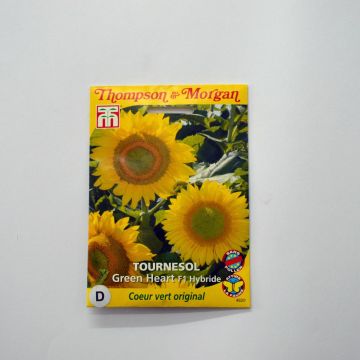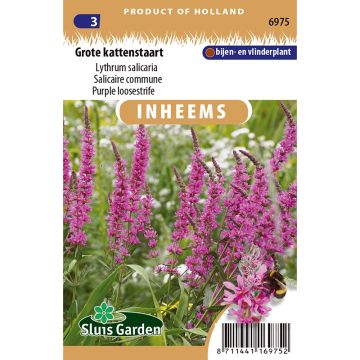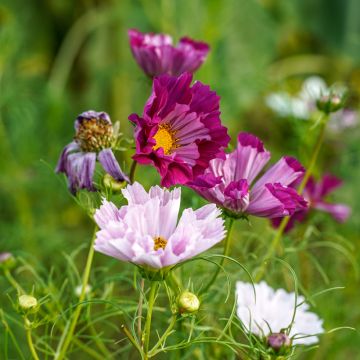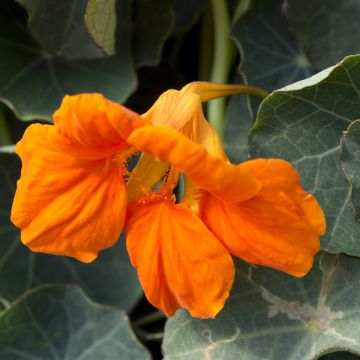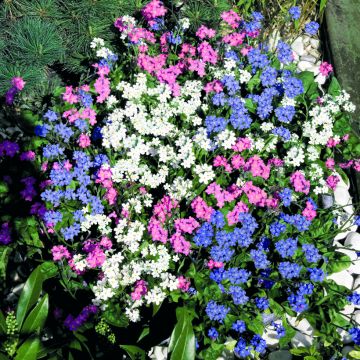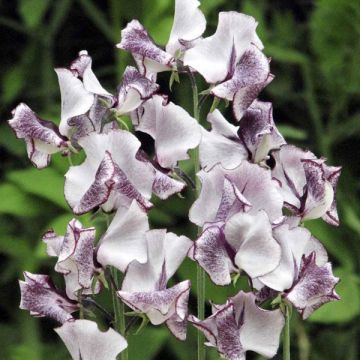

Lobelia Erinus Paper Moon
Lobelia erinus Paper Moon - Trailing Lobelia seeds
Lobelia erinus Paper Moon
Edging Lobelia, Garden Lobelia, Trailing Lobelia
The seedlings did not produce any plants despite two rounds of trials.
laetitia S., 27/08/2017
This plant carries a 6 months recovery warranty
More information
We guarantee the quality of our plants for a full growing cycle, and will replace at our expense any plant that fails to recover under normal climatic and planting conditions.
Seed-only orders are dispatched by sealed envelope. The delivery charge for seed-only orders is €3.90.
Does this plant fit my garden?
Set up your Plantfit profile →
Description
Lobelia erinus 'Paper Moon' is a small, compact, herbaceous annual, widely used for hanging baskets and summer planters. Its numerous, bright white flowers resemble small butterflies and bloom continuously from June to September. They stand out against its light green foliage. Its compact habit gives volume to compositions.
Lobelia erinus is a must-have for container gardening. Its numerous, slender, branching stems form a ball that fills hanging baskets throughout the summer and blends in with taller summer plants. Its small, alternate, obovate, and slightly crinkled leaves create a background for the many flowers that bloom all summer. Approximately 1 cm (0in) in size, the flowers are tubular at the base and then flare out into three downward petals and two small upward ones, resembling insect antennae. They are regularly visited by pollinating insects.
Lobelia also works on its own in pots, brightening up every corner of patios and terraces. You can plant it to border the edge of a flower bed, especially if you have a small garden, preferably in a sunny (not scorching) spot, or partial shade. Just make sure not to let it dry out, which it doesn't like. It prefers moist but not waterlogged soil. An application of fertiliser will give it even more vigour, and if the climate is suitable, it will easily bloom until October.
The 'Paper Moon' Lobelia has a brightness that is very useful for enhancing soft and pastel compositions. It adds dynamism to compositions with outdated colours. You can also pair it with darker summer plants to create contrast, such as Calibrachoa Sweet Bells Midnight Blue or Petunia Mystical Black Magic. Sow lots of this Lobelia, will always find a place for it among the summer plants in your containers.
Attention, these seeds are reserved for experienced gardeners who are used to sowing very fine seeds. These seeds are as fine as dust and barely visible to the naked eye.
Report an error about the product description
Flowering
Foliage
Plant habit
Botanical data
Lobelia
erinus
Paper Moon
Lobeliaceae (Campanulaceae)
Edging Lobelia, Garden Lobelia, Trailing Lobelia
Cultivar or hybrid
Other Thompson and Morgan seeds
Planting and care
Lobelia 'Paper Moon' is best sown under shelter in a tray from March, as the seeds prefer a temperature between 18 and 24°C to germinate
To distribute the fine seeds of the Lobelia more easily, mix them with a little sand. Just cover the seeds with a very thin layer of soil, kept slightly moist. Place them in the sun (essential) and if possible wrap the tray in transparent plastic film during germination. They will sprout between 14 and 21 days. As soon as they emerge, remove the protective film. When the seedlings are large enough to be moved, you can separate them, put them in pots if the freezing period is not over and keep them warm. Otherwise, plant them in flowerbeds or pots. You can gradually acclimatise them if the nights are still cool by taking them out of their shelter during the day. They prefer rich substrate, not too waterlogged.
Make sure to water Lobelias regularly, but not to excess.
Sowing period
Intended location
-
, onOrder confirmed
Reply from on Promesse de fleurs
Flower seeds
Haven't found what you were looking for?
Hardiness is the lowest winter temperature a plant can endure without suffering serious damage or even dying. However, hardiness is affected by location (a sheltered area, such as a patio), protection (winter cover) and soil type (hardiness is improved by well-drained soil).

Photo Sharing Terms & Conditions
In order to encourage gardeners to interact and share their experiences, Promesse de fleurs offers various media enabling content to be uploaded onto its Site - in particular via the ‘Photo sharing’ module.
The User agrees to refrain from:
- Posting any content that is illegal, prejudicial, insulting, racist, inciteful to hatred, revisionist, contrary to public decency, that infringes on privacy or on the privacy rights of third parties, in particular the publicity rights of persons and goods, intellectual property rights, or the right to privacy.
- Submitting content on behalf of a third party;
- Impersonate the identity of a third party and/or publish any personal information about a third party;
In general, the User undertakes to refrain from any unethical behaviour.
All Content (in particular text, comments, files, images, photos, videos, creative works, etc.), which may be subject to property or intellectual property rights, image or other private rights, shall remain the property of the User, subject to the limited rights granted by the terms of the licence granted by Promesse de fleurs as stated below. Users are at liberty to publish or not to publish such Content on the Site, notably via the ‘Photo Sharing’ facility, and accept that this Content shall be made public and freely accessible, notably on the Internet.
Users further acknowledge, undertake to have ,and guarantee that they hold all necessary rights and permissions to publish such material on the Site, in particular with regard to the legislation in force pertaining to any privacy, property, intellectual property, image, or contractual rights, or rights of any other nature. By publishing such Content on the Site, Users acknowledge accepting full liability as publishers of the Content within the meaning of the law, and grant Promesse de fleurs, free of charge, an inclusive, worldwide licence for the said Content for the entire duration of its publication, including all reproduction, representation, up/downloading, displaying, performing, transmission, and storage rights.
Users also grant permission for their name to be linked to the Content and accept that this link may not always be made available.
By engaging in posting material, Users consent to their Content becoming automatically accessible on the Internet, in particular on other sites and/or blogs and/or web pages of the Promesse de fleurs site, including in particular social pages and the Promesse de fleurs catalogue.
Users may secure the removal of entrusted content free of charge by issuing a simple request via our contact form.
The flowering period indicated on our website applies to countries and regions located in USDA zone 8 (France, the United Kingdom, Ireland, the Netherlands, etc.)
It will vary according to where you live:
- In zones 9 to 10 (Italy, Spain, Greece, etc.), flowering will occur about 2 to 4 weeks earlier.
- In zones 6 to 7 (Germany, Poland, Slovenia, and lower mountainous regions), flowering will be delayed by 2 to 3 weeks.
- In zone 5 (Central Europe, Scandinavia), blooming will be delayed by 3 to 5 weeks.
In temperate climates, pruning of spring-flowering shrubs (forsythia, spireas, etc.) should be done just after flowering.
Pruning of summer-flowering shrubs (Indian Lilac, Perovskia, etc.) can be done in winter or spring.
In cold regions as well as with frost-sensitive plants, avoid pruning too early when severe frosts may still occur.
The planting period indicated on our website applies to countries and regions located in USDA zone 8 (France, United Kingdom, Ireland, Netherlands).
It will vary according to where you live:
- In Mediterranean zones (Marseille, Madrid, Milan, etc.), autumn and winter are the best planting periods.
- In continental zones (Strasbourg, Munich, Vienna, etc.), delay planting by 2 to 3 weeks in spring and bring it forward by 2 to 4 weeks in autumn.
- In mountainous regions (the Alps, Pyrenees, Carpathians, etc.), it is best to plant in late spring (May-June) or late summer (August-September).
The harvesting period indicated on our website applies to countries and regions in USDA zone 8 (France, England, Ireland, the Netherlands).
In colder areas (Scandinavia, Poland, Austria...) fruit and vegetable harvests are likely to be delayed by 3-4 weeks.
In warmer areas (Italy, Spain, Greece, etc.), harvesting will probably take place earlier, depending on weather conditions.
The sowing periods indicated on our website apply to countries and regions within USDA Zone 8 (France, UK, Ireland, Netherlands).
In colder areas (Scandinavia, Poland, Austria...), delay any outdoor sowing by 3-4 weeks, or sow under glass.
In warmer climes (Italy, Spain, Greece, etc.), bring outdoor sowing forward by a few weeks.


































